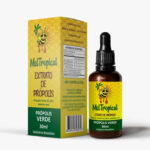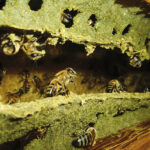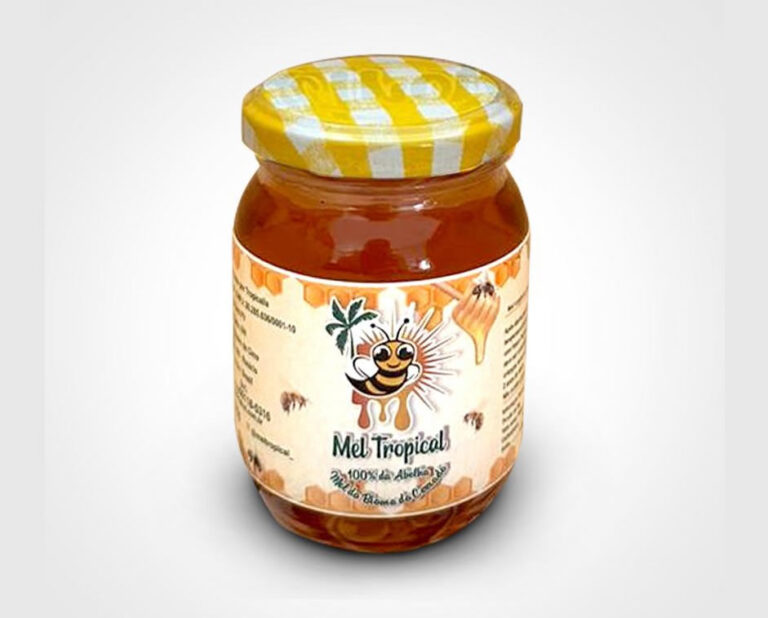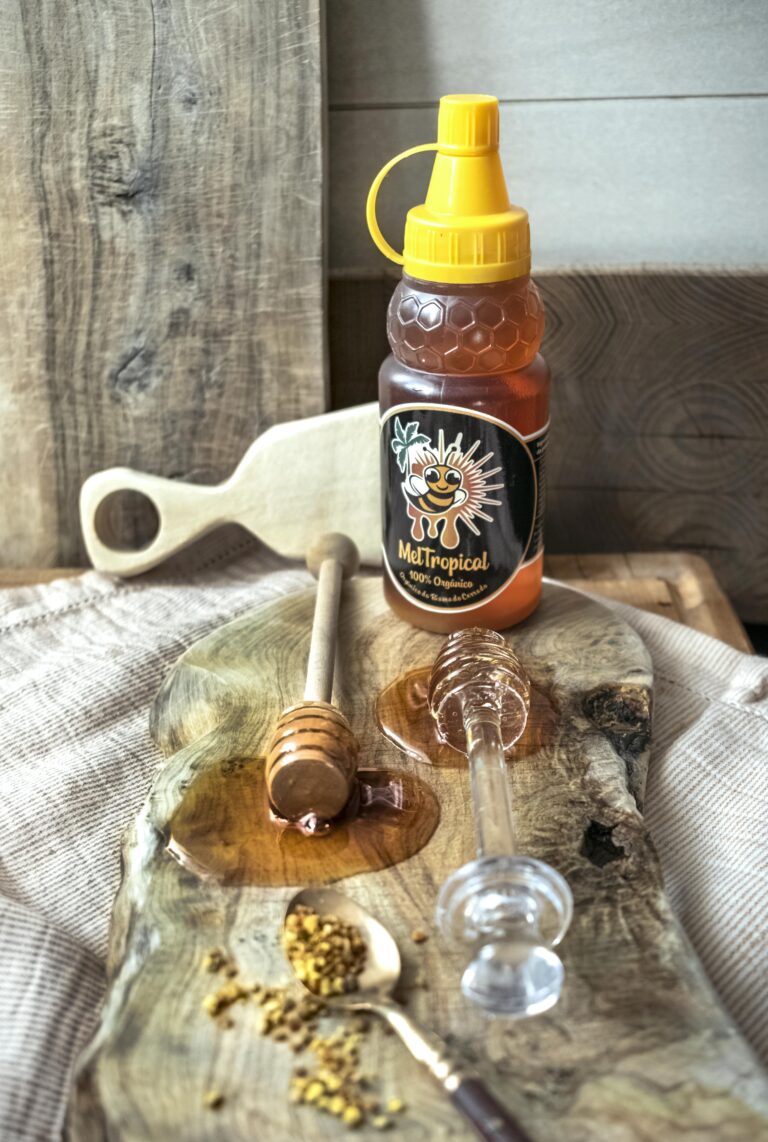
Brazilian green propolis
R$48.80
1000 in stockUnveiling the Power of Nature with Mel Tropical Brazilian Green Propolis
Discover the secrets of well-being with the world’s best propolis – Mel Tropical Green Propolis, containing 25% dry matter. Our packaging provides information on the percentage of flavonoids, phenols, and Artepillin C, essential elements that ensure the high quality and authenticity of our green propolis.
In general, green propolis is a specific type of propolis produced by bees from the plant Baccharis dracunculifolia, known as “field rosemary.” One of the main bioactive compounds present in green propolis is Artepillin C, which possesses various therapeutic properties.
Properties of Artepillin C:
-
Antimicrobial and antibiotic: Effective against various bacteria, including Staphylococcus aureus, Kocuria rhizophila, and fungi of the Candida genus.
-
Anti-inflammatory and immunomodulatory: Helps regulate the immune system and reduce inflammatory processes.
-
Antioxidant: Protects cells from oxidative damage by neutralizing free radicals.
-
Antitumor: Studies indicate anticancer efficacy in different contexts, including laryngeal and prostate cancer.
-
Wound healing: Aids in the recovery of wounds and skin ulcers.
-
Oral health: Helps prevent cavities caused by Streptococcus mutans.
-
Overview:
Brazilian Green Propolis is a unique and worlds most potent variety of propolis produced by honeybees using the resin from medicinal plant Baccharis dracunculifolia , common name Alecrim do Campo, a plant native to the pristine Brazilian Cerrado.
Our propolis is made up of 50% resin, 30% wax, 10% aromatic compounds (essential oils) and 10% pollen and other substances.
Most important thing related to Brazilian green propolis is the presence of a unique natural chemical compound Artepillin-C , which is a resinous substance produced by bees from the Alecrim do campo plant. It belongs to a class of compounds known as phenolic compounds, specifically a type of phenolic acid called prenylated phenolic acid. Artepillin-C has gained attention due to its enormous potential health benefits, including antioxidant, anti-inflammatory, antimicrobial, and extremely high anticancer properties.
Mel Tropical green propolis presents a unique blend of flavors – slightly tangy, subtly sweet, herb-like smell and a unique bitter and pungent taste.
Geography: Cerrado ( Brazilian savanna , cover area around 2 million square kilometer ).
Floral Source:
Mel Tropical Green propolis derives mainly from vegetative spices of Baccharis dracunculifolia , Alecrim do campo plants.
This plant naturally occurring in the South, Southeast and Center-West regions, up to the south of Brazilian Nord East.
Properties:
Wide range of studies describing Brazilian green propolis beneficial properties such as
anticancerogenic (inhibiting the development of different type of cancers ), antiviral , antiulcerogenic, anti-inflammatory, antimutagenic, antifungal, angiogenesis, antioxidant ( specially in patients with type 2 diabetes mellitus ), antiherpetic and immunomodulatory. Different from most European propolis extracts, which present flavonoids as the major component responsible for their effects, the biological activities of Brazilian green propolis are due to its high levels of phenolic acids such as Artepillin C !!
Brazilian Green propolis is ultimate nature remedy , no.1 choice for improving the immune system and treating flu, colds , respiratory problem and any sort of infections and inflamatation.
With the regular use of Mel tropical Brazilian green propolise you and your family get for affordable money ultimate health protection….think about that….
Anti tumor activities:
The Brazilian Propolis, due to its differentiation, has been generating a lot of interest from researchers, which has antioxidant, antimicrobial, anti-inflammatory and scientific proved anti-tumor activities, has as main component Artepillin C (ARC). There are numerous articles and researches in order to explore the benefits of Brazilian green propolis and its components and agents that act against the growth of tumor cells, reduce inflammation and angiogenesis , in the control and inhibition of lung , colorectal , prostate , kidney cancer, and especially melanoma. Artepillin C as a crucial component of Brazilian green propolis demonstrated that its application in malignant, tumor cells cause a cytotoxic effect by inhibiting the growth of tumor cells, highlighting the damage caused by this substance in cancer cells. Animals with renal cell-induced carcinomas were treated with artepillin C and demonstrated a protective effect against lipid peroxidation, preventing the formation of these carcinomas. Recent studies involving Artepillin C and colorectal cancer evidenced that after the ARC treatment, there was a reduction in colorectal cancer. ARC demonstrated action against different tumor cells observed in prostate cancer in vitro, affecting cancer cells by inhibiting their cell growth, inducing apoptosis. The studies demonstrated here suggest the ability of propolis to inhibit and proliferate the cell cycle or to induce apoptosis in tumor cells.
Antimicrobial activity:
Big number of studies have shown the activity of Brazilian green propolis against several pathogenic bacteria, including Gram positive bacteria (S. aureus, Staphylococcus epidermidis,
Streptococcus pneumoniae, and Kocuria rhizophila) and Gram negative bacteria (Haemophilus influenzae, Porphyromonas gingivalis, Porphyromonas endodontalis, and Prevotella denticola).
The last three bacteria cause periodontal diseases, which affect the periodontal tissues(tooth supporting tissues). Furthermore, green propolis is active against cariogenic bacteria,such as Streptococcus mutans ( oral infections , dental caries ), Streptococcus sobrinus ( oral infections , dental caries ), Streptococcus salivarius ( tonsillopharyngitis , sore throat ) , Streptococcus sanguinis (subacute bacterial endocarditis), and Lactobacillus casei (endocarditis, bacteremia, neonatal meningitis, dental caries, and intra-abdominal abscesses including liver abscess, pancreatic ) .
Antifungal activity :
Brazilian green propolis has been reported against all three morphotypes of Candida albican( yeast, pseudohyphae, and hyphae) which cause oral or vaginal candidiasis. At the cellular level, propolis is able to induce apoptosis and secondary necrosis in yeasts. Antimycotic effect of green propolis in patients with tinea pedis interdigitalis ( athlete’s foot or foot ringworm ) and tinea corporis ( ringworm ) caused by Trichophyton rubrum.
Antiviral activity:
It is significant capacity of Brazilian green propolis to inhibit virus propagation. Ethanol extract of green propolis exhibited moderate efficacy in limiting herpetic skin lesions caused by herpes simplex virus type 1 (HSV-1) aswell anti-influenza effect (H1N1 influenza virus) of the water extract of green propolis and its caffeoylquinic acids, which may have a cytoprotective action by affecting the internal cellular process.
Antioxidant activity :
The propolis antioxidant property is one of the most studied biological activities worldwide. This biological property presents outstanding importance in the general benefits that propolis may bring to human health as the free radical scavenging capacity of propolis compounds may be closely related to the anti-inflammatory, antimicrobial, anticancer activities, as well as,
prevention of atherosclerosis, skin damages, ageing, and among others. Phenolic compounds have been reported as the main propolis compounds responsible for the antioxidant property. However, it is known that other than phenolic compounds, flavonoids are involved in the antioxidant activity of propolis. Brazilian green propolis ethanolic extract protects blood vessel endothelial cells oxidized low density lipoprotein (ox-LDL)induced apoptosis and inhibits atherosclerotic lesion development. Performed studies showed that use of topically and orally administered Brazilian green propolis extract can prevent UV irradiation-induced oxidative stress in skin. Brazilian Green propolis also due to its antioxidant properties was tested against acute lung inflammation (ALI) caused by cigarette smoke (CS) in vivo. The researchers observed that Brazilian green propolis treatment (200 mg/kg) normalized all biochemical parameters ,including nitrite, myeloperoxidase level, antioxidant enzyme activities (superoxide dismutase, catalase and glutathione peroxidase), reduced glutathione/oxidized glutathione ratio, and malondialdehyde. Regarding the influence of the Brazilian green propolis antioxidant activity in food preservation, whencombined with heat treatment in apple juice, propolis (0.1 mg/ml) reduced the thermal treatment time and temperature needed to inactivate 5 log10 cycles of E. coli. No influence on organoleptic properties of the apple juice, which implies the possibility of obtaining a sensorially appealing, low-pasteurized apple juice with the functional properties provided by Brazilian green propolis was reached.
Immunoregulator:
One of the biological effects of propolis is its immunomodulatory effect—by either enhancing or suppressing the immune system. This contradictory effect is probably due to its complex chemical variety, the presence in different geographic regions, and the different forms of extraction. Immunomodulatory as well as anti-inflammatory effects of Brazilian green propolis have been widely demonstrated. These effects are mainly related to its constituents, especially the phenolic compounds,including flavonoids as major components. Among the main types of flavonoids contained in propolis are: pinocebrin, chrisin, and caffeic acid phenethyl ester (CAPE). In addition to flavonoids, Brazilian green propolis can also contain cinnamic acid derivatives such as caffeic acid and its esters, besides sesquiterpenes, quinones, and coumarins. The typical constituents of Brazilian propolis, especially the Brazilian green propolis, are: caffeoylquinic acid and prenylated derivatives of cinnamic acid, such as artepillin C, p-coumaric acid, baccharin, and drupanin. Brazilian green propolis extract was capable to inhibit the cytokine production by provoking certain immunomodulatory actions. The immunomodulatory activity of Brazilian green propolis extract was also subject of in vivo study using the ovalbumin (OVA)-induced asthma model , research demonstrated that propolis extracts can suppress the serum levels of OVA-specific antibody IgE and IgG1 and attenuate the airway inflammation, probably by the ability of Brazilian green propolis to modulate cytokine production. These findings suggest that propolis extracts should be a potential novel therapeutic agent for asthma.
Usage:
Mel tropical Brazilian green propolis alcoholic tincture (extractive solution):
- -10 drops diluted in water, or in a dessert spoon of honey, three times a day.
- in the case of gargling and mouthwash, dilute 15 drops in half a glass of water.
Time of delivery : usually 3 to 7 working days , option for delivery on the desired date
Price incl. VAT without shipping , international shipping available
-
Description
Overview:
Brazilian Green Propolis is a unique and worlds most potent variety of propolis produced by honeybees using the resin from medicinal plant Baccharis dracunculifolia , common name Alecrim do Campo, a plant native to the pristine Brazilian Cerrado.
Our propolis is made up of 50% resin, 30% wax, 10% aromatic compounds (essential oils) and 10% pollen and other substances.
Most important thing related to Brazilian green propolis is the presence of a unique natural chemical compound Artepillin-C , which is a resinous substance produced by bees from the Alecrim do campo plant. It belongs to a class of compounds known as phenolic compounds, specifically a type of phenolic acid called prenylated phenolic acid. Artepillin-C has gained attention due to its enormous potential health benefits, including antioxidant, anti-inflammatory, antimicrobial, and extremely high anticancer properties.
Mel Tropical green propolis presents a unique blend of flavors – slightly tangy, subtly sweet, herb-like smell and a unique bitter and pungent taste.
Geography: Cerrado ( Brazilian savanna , cover area around 2 million square kilometer ).
Floral Source:
Mel Tropical Green propolis derives mainly from vegetative spices of Baccharis dracunculifolia , Alecrim do campo plants.
This plant naturally occurring in the South, Southeast and Center-West regions, up to the south of Brazilian Nord East.
Properties:
Wide range of studies describing Brazilian green propolis beneficial properties such as
anticancerogenic (inhibiting the development of different type of cancers ), antiviral , antiulcerogenic, anti-inflammatory, antimutagenic, antifungal, angiogenesis, antioxidant ( specially in patients with type 2 diabetes mellitus ), antiherpetic and immunomodulatory. Different from most European propolis extracts, which present flavonoids as the major component responsible for their effects, the biological activities of Brazilian green propolis are due to its high levels of phenolic acids such as Artepillin C !!
Brazilian Green propolis is ultimate nature remedy , no.1 choice for improving the immune system and treating flu, colds , respiratory problem and any sort of infections and inflamatation.
With the regular use of Mel tropical Brazilian green propolise you and your family get for affordable money ultimate health protection….think about that….
Anti tumor activities:
The Brazilian Propolis, due to its differentiation, has been generating a lot of interest from researchers, which has antioxidant, antimicrobial, anti-inflammatory and scientific proved anti-tumor activities, has as main component Artepillin C (ARC). There are numerous articles and researches in order to explore the benefits of Brazilian green propolis and its components and agents that act against the growth of tumor cells, reduce inflammation and angiogenesis , in the control and inhibition of lung , colorectal , prostate , kidney cancer, and especially melanoma. Artepillin C as a crucial component of Brazilian green propolis demonstrated that its application in malignant, tumor cells cause a cytotoxic effect by inhibiting the growth of tumor cells, highlighting the damage caused by this substance in cancer cells. Animals with renal cell-induced carcinomas were treated with artepillin C and demonstrated a protective effect against lipid peroxidation, preventing the formation of these carcinomas. Recent studies involving Artepillin C and colorectal cancer evidenced that after the ARC treatment, there was a reduction in colorectal cancer. ARC demonstrated action against different tumor cells observed in prostate cancer in vitro, affecting cancer cells by inhibiting their cell growth, inducing apoptosis. The studies demonstrated here suggest the ability of propolis to inhibit and proliferate the cell cycle or to induce apoptosis in tumor cells.
Antimicrobial activity:
Big number of studies have shown the activity of Brazilian green propolis against several pathogenic bacteria, including Gram positive bacteria (S. aureus, Staphylococcus epidermidis,
Streptococcus pneumoniae, and Kocuria rhizophila) and Gram negative bacteria (Haemophilus influenzae, Porphyromonas gingivalis, Porphyromonas endodontalis, and Prevotella denticola).
The last three bacteria cause periodontal diseases, which affect the periodontal tissues(tooth supporting tissues). Furthermore, green propolis is active against cariogenic bacteria,such as Streptococcus mutans ( oral infections , dental caries ), Streptococcus sobrinus ( oral infections , dental caries ), Streptococcus salivarius ( tonsillopharyngitis , sore throat ) , Streptococcus sanguinis (subacute bacterial endocarditis), and Lactobacillus casei (endocarditis, bacteremia, neonatal meningitis, dental caries, and intra-abdominal abscesses including liver abscess, pancreatic ) .
Antifungal activity :
Brazilian green propolis has been reported against all three morphotypes of Candida albican( yeast, pseudohyphae, and hyphae) which cause oral or vaginal candidiasis. At the cellular level, propolis is able to induce apoptosis and secondary necrosis in yeasts. Antimycotic effect of green propolis in patients with tinea pedis interdigitalis ( athlete’s foot or foot ringworm ) and tinea corporis ( ringworm ) caused by Trichophyton rubrum.
Antiviral activity:
It is significant capacity of Brazilian green propolis to inhibit virus propagation. Ethanol extract of green propolis exhibited moderate efficacy in limiting herpetic skin lesions caused by herpes simplex virus type 1 (HSV-1) aswell anti-influenza effect (H1N1 influenza virus) of the water extract of green propolis and its caffeoylquinic acids, which may have a cytoprotective action by affecting the internal cellular process.
Antioxidant activity :
The propolis antioxidant property is one of the most studied biological activities worldwide. This biological property presents outstanding importance in the general benefits that propolis may bring to human health as the free radical scavenging capacity of propolis compounds may be closely related to the anti-inflammatory, antimicrobial, anticancer activities, as well as,
prevention of atherosclerosis, skin damages, ageing, and among others. Phenolic compounds have been reported as the main propolis compounds responsible for the antioxidant property. However, it is known that other than phenolic compounds, flavonoids are involved in the antioxidant activity of propolis. Brazilian green propolis ethanolic extract protects blood vessel endothelial cells oxidized low density lipoprotein (ox-LDL)induced apoptosis and inhibits atherosclerotic lesion development. Performed studies showed that use of topically and orally administered Brazilian green propolis extract can prevent UV irradiation-induced oxidative stress in skin. Brazilian Green propolis also due to its antioxidant properties was tested against acute lung inflammation (ALI) caused by cigarette smoke (CS) in vivo. The researchers observed that Brazilian green propolis treatment (200 mg/kg) normalized all biochemical parameters ,including nitrite, myeloperoxidase level, antioxidant enzyme activities (superoxide dismutase, catalase and glutathione peroxidase), reduced glutathione/oxidized glutathione ratio, and malondialdehyde. Regarding the influence of the Brazilian green propolis antioxidant activity in food preservation, whencombined with heat treatment in apple juice, propolis (0.1 mg/ml) reduced the thermal treatment time and temperature needed to inactivate 5 log10 cycles of E. coli. No influence on organoleptic properties of the apple juice, which implies the possibility of obtaining a sensorially appealing, low-pasteurized apple juice with the functional properties provided by Brazilian green propolis was reached.
Immunoregulator:
One of the biological effects of propolis is its immunomodulatory effect—by either enhancing or suppressing the immune system. This contradictory effect is probably due to its complex chemical variety, the presence in different geographic regions, and the different forms of extraction. Immunomodulatory as well as anti-inflammatory effects of Brazilian green propolis have been widely demonstrated. These effects are mainly related to its constituents, especially the phenolic compounds,including flavonoids as major components. Among the main types of flavonoids contained in propolis are: pinocebrin, chrisin, and caffeic acid phenethyl ester (CAPE). In addition to flavonoids, Brazilian green propolis can also contain cinnamic acid derivatives such as caffeic acid and its esters, besides sesquiterpenes, quinones, and coumarins. The typical constituents of Brazilian propolis, especially the Brazilian green propolis, are: caffeoylquinic acid and prenylated derivatives of cinnamic acid, such as artepillin C, p-coumaric acid, baccharin, and drupanin. Brazilian green propolis extract was capable to inhibit the cytokine production by provoking certain immunomodulatory actions. The immunomodulatory activity of Brazilian green propolis extract was also subject of in vivo study using the ovalbumin (OVA)-induced asthma model , research demonstrated that propolis extracts can suppress the serum levels of OVA-specific antibody IgE and IgG1 and attenuate the airway inflammation, probably by the ability of Brazilian green propolis to modulate cytokine production. These findings suggest that propolis extracts should be a potential novel therapeutic agent for asthma.
Usage:
Mel tropical Brazilian green propolis alcoholic tincture (extractive solution):
- -10 drops diluted in water, or in a dessert spoon of honey, three times a day.
- in the case of gargling and mouthwash, dilute 15 drops in half a glass of water.
Time of delivery : usually 3 to 7 working days , option for delivery on the desired date
Price incl. VAT without shipping , international shipping available






